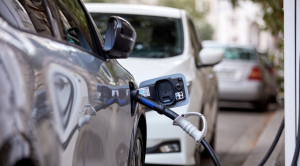
We’re excited to share that Charging Smart has been helping communities accelerate transportation electrification for over a year! The technical assistance and designation program, which GPI originally piloted in the Midwest, has now expanded nationwide. Dozens of cities and towns across the country are pursuing designation, with new communities joining every day.
Since Charging Smart began, electric vehicle (EV) technology has progressed, and planning and policy best practices have evolved. In January 2025, an advisory committee of experts in EV charging and local government convened to update the program, reflecting these changes and the lessons learned from the first year of operation. These updates showcase Charging Smart’s ability to adapt to the ever-evolving EV landscape while remaining flexible enough to be implemented in communities of all shapes and sizes.
This post highlights these recent changes to Charging Smart and how they can benefit communities participating in the program. But first, a brief overview of the program.
Charging Smart overview
Charging Smart is funded by the US Department of Energy’s Vehicle Technologies Office and led by the Interstate Renewable Energy Council, with GPI serving as a lead partner. The program offers free technical assistance to local governments, giving them tools to support EV adoption and achieve related community goals, such as cleaner air, economic growth, and sustainable mobility.
Charging Smart recognizes and celebrates community progress through Bronze, Silver, and Gold level designations. Each designation level requires communities to complete specific actions, called criteria, that have demonstrated efficacy in advancing transportation electrification. Read more about the program structure in our Charging Smart 101 blog post.
What’s new in 2025 for Charging Smart communities?
The updates to Charging Smart in 2025 include changes to the requirements for Silver and Gold designations, new criteria, and revisions to existing ones. A new metrics reporting requirement has also been added, which asks communities to track key data points related to EVs and EV charging infrastructure.
Changes to the program were determined based on feedback from participating communities and technical assistance providers. This year’s changes are intended to increase the flexibility, efficiency, and effectiveness of Charging Smart, allowing communities of all shapes and sizes to join the nationwide movement toward transportation electrification.
Updated requirements for Silver and Gold designations
The key changes to the required criteria for Gold and Silver designations include the following:
- Fleet Analysis: Communities seeking Silver designation are now required to complete an initial fleet analysis, which is less comprehensive and less time-intensive than the prior requirements. A more detailed comprehensive fleet analysis is now required to receive Gold designation.
- Planning requirements: Communities can now address EVs in either comprehensive or functional plans (such as climate action plans or transportation plans) and still qualify for Gold designation.
- EV-ready ordinances: To achieve Gold designation, communities can now choose between passing an EV-ready ordinance or defining primary use standards for EV charging as its own use (not as a gas station) within their zoning code.
- Fleet electrification: Communities can now choose between purchasing light-duty EVs for municipal fleets or purchasing medium/heavy-duty EVs, with either option satisfying the requirements for Gold designation.
Additions and changes to criteria
In addition to the changes to the Gold and Silver designation requirements, new criteria have been added to the regulation, education and incentives, and government operations program categories.
Regulatory requirements
- Streamlined site review: Communities can now receive credit for adopting expedited site plan reviews for EV charging projects.
- EV charging station accessibility: New criteria promote accessibility in EV charging spaces, helping to ensure that new EV infrastructure is designed with the needs of all community members in mind.
- Staff training: New criteria call for implementing the most current model building and electrical codes for EV chargers and training relevant staff in these updated codes.
Education and incentives requirements
- Workforce development: New criteria emphasize the importance of workforce development in the EV space by promoting EV charging job training and other career opportunities.
Government operations requirements
- Fleet electrification: New criteria give communities credit for electrifying 5 percent of their light-duty fleet or 5 percent of their medium- or heavy-duty fleet.
- Emergency response: New criteria call for training emergency response personnel on potential EV and charging infrastructure emergencies, such as EV battery fires.
Introducing metrics reporting
Along with the additions and changes to program criteria, another new element of Charging Smart in 2025 is the metrics reporting requirement for communities. Communities are now asked to track specific data points, including the number of registered EVs, installed EV chargers, and metrics on EV charger permitting.
This new requirement will allow program partners and communities to track key performance indicators and better understand successes and opportunities for improvement.
Charging Smart continues to evolve
These program updates are expected to be the first of many, with an annual review cycle allowing for lessons learned, emerging best practices, and changes to EV technology to be accounted for and incorporated. By staying up to date on the rapidly evolving EV landscape, the program will continue to remain flexible and serve as a valuable resource for communities navigating the transition to transportation electrification.
As the EV landscape evolves, so will Charging Smart, serving as a dynamic and responsive tool for local governments. To learn more about the program, watch our Charging Smart 101 webinar and visit the Charging Smart website. For an in-depth look into Charging Smart and the most up-to-date version of program criteria and requirements, review the Charging Smart Program Guide.
If you are interested in participating in the program, fill out this form. If you have any questions about the program, please contact us at info_[email protected].


